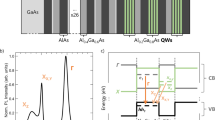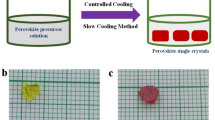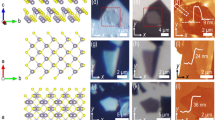Abstract
IN recent years the dispersion of the stress optical coefficients of diamond1, the alkali halides2 and magnesium oxide3 has been determined in the visible range of wave-lengths. The dispersion in fused quartz4,5 has also been investigated from 5700 to 2500 A. The observed dispersion is of the order of a few per cent for all these materials. In the present investigation the dispersion of the stress optical coefficient C = n
3(q
11 – q
12)/2 has been determined from the visible range to 2400 A. The method of measurement combines the differential feature of Bansigir and Iyengar's2 method with the photographic method of Jog6. Using fused quartz (presented by the Thermal Syndicate to Prof. R. S. Krishnan) as the standard, the stress optical coefficient of the alkali halides is obtained by determining the position of the dark bands in the spectrum of light polarized at 45° to the direction of stress and passed through the fused quartz specimen loaded suitably, the stressed alkali halide crystal and an analyser in the crossed position. The position of the dark bands is determined by the equation:  where C is the stress optical coefficient of the material for wave-length λ; W is the load applied on it; t is its thickness and n is the order of the band. C
1, W
1 and t
1 refer to the standard and C, W and t to the alkali halide used.
where C is the stress optical coefficient of the material for wave-length λ; W is the load applied on it; t is its thickness and n is the order of the band. C
1, W
1 and t
1 refer to the standard and C, W and t to the alkali halide used.
This is a preview of subscription content, access via your institution
Access options
Subscribe to this journal
Receive 51 print issues and online access
$199.00 per year
only $3.90 per issue
Buy this article
- Purchase on SpringerLink
- Instant access to full article PDF
Prices may be subject to local taxes which are calculated during checkout
Similar content being viewed by others
References
Poindexter, E., Amer. Mineralogist, 40, 1032 (1955).
Bansigir, K. G., and Iyengar, K. S., Proc. Phys. Soc., 71, 225 (1958).
Giardini, A. A., and Poindexter, E., J. Opt. Soc. Amer., 48, 556 (1958).
Jog, E. S., and Krishnan, R. S., Nature, 179, 540 (1957).
Krishnan, R. S., Jog, E. S., and Srinivasan, R., Nature, 181, 692 (1958).
Jog, E. S., J. Ind. Inst. Sci., A, 39, 93 (1957).
Burstein, E., and Smith, P. L., Phys. Rev., 74, 229 (1948).
Pockels, F., Ann. Phys. Lpz., 37, 151 (1889).
West, C. D., and Makas, A. B., J. Chem. Phys., 16, 427 (1948).
Mueller, H., Phys. Rev., 47, 947 (1935).
Author information
Authors and Affiliations
Rights and permissions
About this article
Cite this article
SRINIVASAN, R. Dispersion of the Stress Optical Coefficient of the Alkali Halides. Nature 182, 1660–1661 (1958). https://doi.org/10.1038/1821660b0
Issue date:
DOI: https://doi.org/10.1038/1821660b0
This article is cited by
-
Dispersion of the stress-optic coefficient of lithium fluoride
Die Naturwissenschaften (1961)



